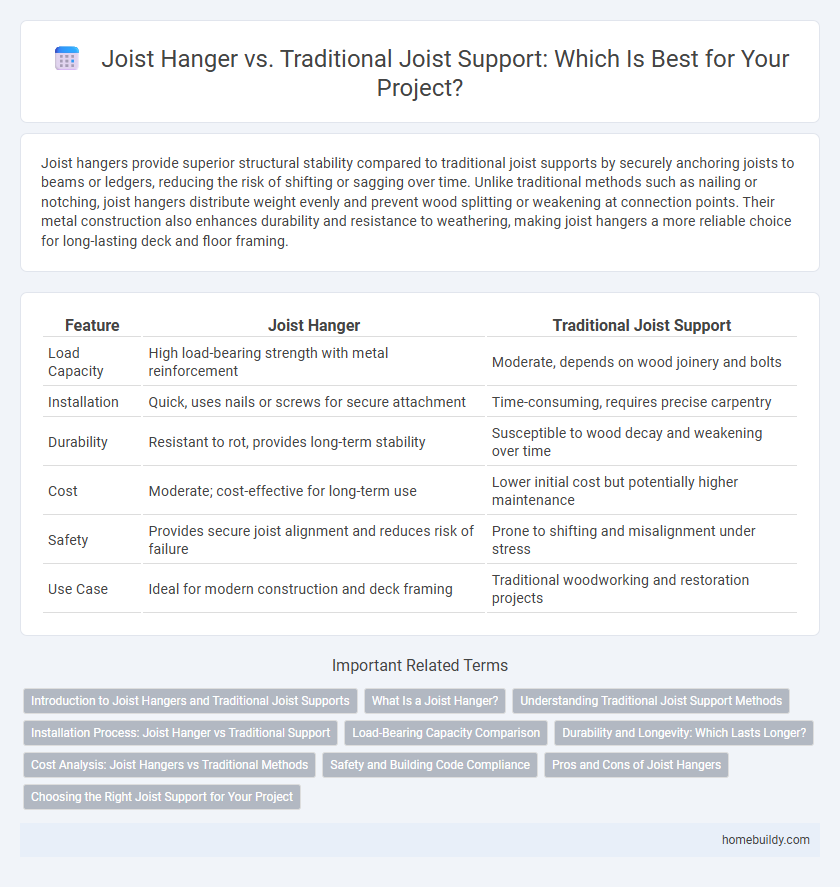Joist hangers provide superior structural stability compared to traditional joist supports by securely anchoring joists to beams or ledgers, reducing the risk of shifting or sagging over time. Unlike traditional methods such as nailing or notching, joist hangers distribute weight evenly and prevent wood splitting or weakening at connection points. Their metal construction also enhances durability and resistance to weathering, making joist hangers a more reliable choice for long-lasting deck and floor framing.
Table of Comparison
| Feature | Joist Hanger | Traditional Joist Support |
|---|---|---|
| Load Capacity | High load-bearing strength with metal reinforcement | Moderate, depends on wood joinery and bolts |
| Installation | Quick, uses nails or screws for secure attachment | Time-consuming, requires precise carpentry |
| Durability | Resistant to rot, provides long-term stability | Susceptible to wood decay and weakening over time |
| Cost | Moderate; cost-effective for long-term use | Lower initial cost but potentially higher maintenance |
| Safety | Provides secure joist alignment and reduces risk of failure | Prone to shifting and misalignment under stress |
| Use Case | Ideal for modern construction and deck framing | Traditional woodworking and restoration projects |
Introduction to Joist Hangers and Traditional Joist Supports
Joist hangers provide superior structural support by securely fastening joists to beams or ledger boards, ensuring even load distribution and enhanced stability compared to traditional methods. Traditional joist supports, such as ledger strips or ledgers nailed directly to posts, often rely on nails or screws alone, which can lead to weaker connections and potential sagging over time. Using metal joist hangers reduces the risk of wood splitting and improves durability, making them a preferred choice for modern framing projects.
What Is a Joist Hanger?
A joist hanger is a metal bracket specifically designed to provide strong and secure support for wooden joists in construction, ensuring stability and load distribution. Unlike traditional joist supports such as ledger boards or notched beams, joist hangers are pre-fabricated and standardized, allowing for faster installation and consistent alignment. Engineered from galvanized steel, joist hangers resist corrosion and enhance the structural integrity of floors, decks, and ceilings compared to conventional methods.
Understanding Traditional Joist Support Methods
Traditional joist support methods commonly involve the use of ledger boards, masonry walls, or wood blocking to bear the load of floor and ceiling joists. These techniques rely on nails or bolts driven directly into wood or masonry, which can lead to limited load transfer efficiency and potential structural weakness over time. Unlike joist hangers, traditional methods may lack standardized load ratings and often require more maintenance to ensure long-term stability and safety.
Installation Process: Joist Hanger vs Traditional Support
Joist hangers offer a streamlined installation process compared to traditional joist supports, requiring fewer nails and quicker alignment due to pre-formed metal brackets. Traditional supports often involve complex cutting and fitting of wood notches or ledger boards, increasing labor time and potential for errors. Using joist hangers enhances structural consistency and reduces installation errors, making them preferable for both professional builders and DIY enthusiasts.
Load-Bearing Capacity Comparison
Joist hangers provide superior load-bearing capacity compared to traditional joist supports by evenly distributing the weight through metal connectors designed to resist shear and uplift forces. Unlike traditional wooden ledger boards or notches, joist hangers maintain structural integrity by minimizing the risk of wood splitting and deformation under heavy loads. Engineered for higher strength applications, joist hangers significantly enhance overall stability in floor framing systems.
Durability and Longevity: Which Lasts Longer?
Joist hangers, typically made from galvanized steel, offer superior durability compared to traditional notching or ledger board methods, resisting rot, warping, and insect damage more effectively. Their corrosion-resistant coating extends the lifespan of wood connections by preventing moisture-related deterioration, often doubling the longevity of traditional supports exposed to outdoor elements. Studies show that structures using joist hangers can maintain optimal load-bearing capacity for over 50 years, while traditional joist supports may require earlier maintenance or replacement due to compromised integrity.
Cost Analysis: Joist Hangers vs Traditional Methods
Joist hangers offer a cost-effective solution by reducing labor time and minimizing material waste compared to traditional ledger board or notched framing methods. While joist hangers may have a higher upfront material cost, their ease of installation and enhanced structural integrity often result in overall savings on long-term maintenance and repairs. Traditional joist supports typically require more skilled labor and additional materials, increasing total project expenses despite lower initial hardware costs.
Safety and Building Code Compliance
Joist hangers provide enhanced safety by securely anchoring joists to beams, significantly reducing the risk of structural failure compared to traditional notching or toe-nailing methods. Building codes increasingly mandate the use of metal joist hangers to ensure uniform load distribution and adherence to engineering standards, minimizing potential hazards. Compliance with these codes not only guarantees structural integrity but also streamlines inspection and approval processes on construction sites.
Pros and Cons of Joist Hangers
Joist hangers provide superior load distribution and structural stability compared to traditional ledger board support, reducing the risk of joist twisting or sagging while allowing for easier installation and inspection. However, they require precise placement and corrosion-resistant materials, especially in outdoor or high-moisture environments, to prevent premature failure and maintain long-term durability. Traditional joist support may offer a simpler, more cost-effective solution but often lacks the enhanced strength and consistency of joist hanger systems.
Choosing the Right Joist Support for Your Project
Joist hangers provide superior stability and load distribution compared to traditional joist supports, ensuring enhanced structural integrity for decks and flooring systems. Unlike traditional ledger boards or fire-blocking methods, joist hangers offer corrosion-resistant materials like galvanized or stainless steel, increasing durability in outdoor applications. Selecting the appropriate joist hanger size and type based on joist dimensions and load requirements optimizes safety and longevity in construction projects.
joist hanger vs traditional joist support Infographic

 homebuildy.com
homebuildy.com